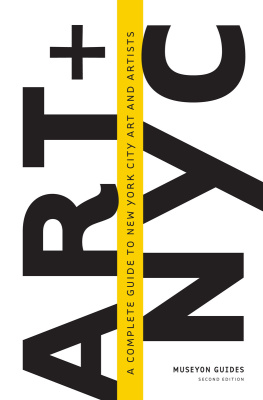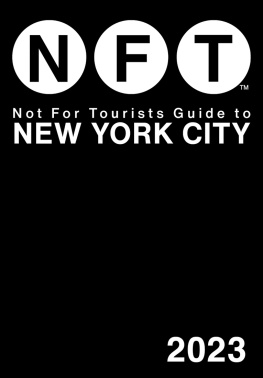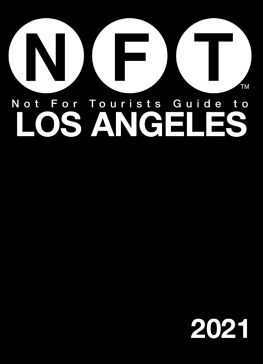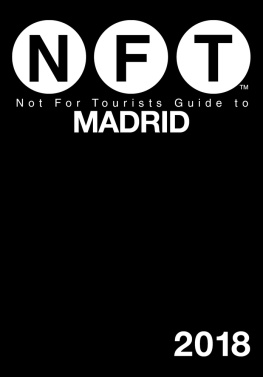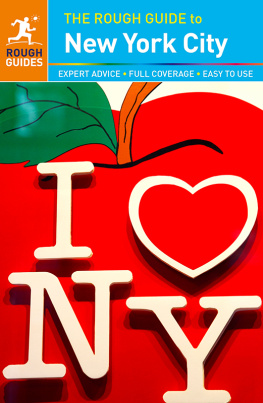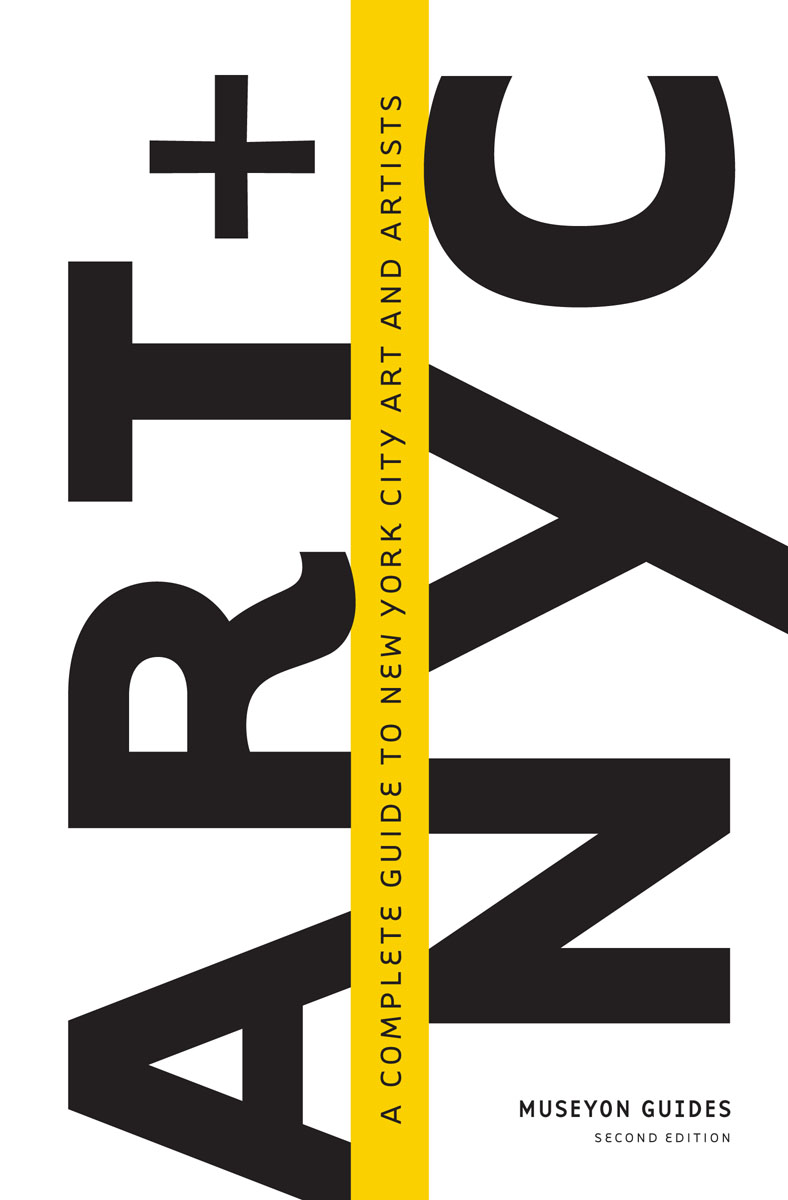
2016 Museyon
All rights reserved. No part of this publication may be copied or transmitted in any form by any means, electronic, mechanical, recording or otherwise, except brief extracts for the purpose of review, and no part of this publication may be sold or hired without the express permission of the publisher.
Library of Congress Cataloging-in-Publication Data
Title: Art and NYC : a complete guide to New York City art and artists.
Other titles: Art and New York City
Description: New York : Museyon, 2016. | Includes index.
Identifiers: LCCN 2016027978 (print) | LCCN 2016028400 (ebook) | ISBN 9781940842110 (pbk.) | ISBN 9781938450884 (e-Pub) | ISBN 9781938450891 (e-PDF) | ISBN 9781938450907 ( Mobi)
Subjects: LCSH: Art, American-New York (State)--New York--20th century. Art, American-New York (State)--New York--21st century. | Art--New York (State)--New York-Guidebooks.
Classification: LCC N6535.N5 A275 2016 (print) | LCC N6535.N5 (ebook) | DDC 709.747/0904--dc23
LC record available at https://lccn.loc.gov/2016027978
Published in the United States by:
Museyon Inc.
1177 Avenue of the Americas, 5th Floor
New York, NY 10036
Museyon is a registered trademark.
Visit us online at www.museyon.com
ISBN 978-1-940842-11-0
0616170
Printed in China
N ew York is a mecca for art lovers from near and far. Each year, 6.3 million people visit The Metropolitan Museum of Art, while the Museum of Modern Art sees 3 million visitors as countless others explore the citys additional offerings, including commercial galleries, historical sites and public spaces. Since absorbing the culture shock of the 1913 Armory Show, New York has led the way, nurturing notable artists and producing many of the styles and movements that have come to define modern and contemporary art. New York Citys art history has shaped the history of art throughout the United States in the 20th and 21st centuries. With this all-encompassing book, readers will learn the stories behind the citys greatest masterpieces and increase their enjoyment of these modern classics. We are very happy to open the gate of art appreciation to art historians, first-time museumgoers and everyone in between.
Get inspired!
TABLE OF CONTENTS
INDEX
FAMOUS WORKS OF ART IN NEW YORK

by Hilda Werschkul
A s home to some of the worlds most famous masterpieces of modern and contemporary art, New York City rivals the leading art and cultural capitals of Europe. Many of these works were recognized in their own time as being highly significant. Others proved important later onsometimes many decades after the artists death due to the unfolding of historical events, which have since shed new light on these stunning artistic achievements. Each work of art discussed here shares this story, a tale about an artist and an idea, the people and places involved, and the circumstancesincluding the genius of dealers, private collectors and museum directors, as well as the cunning agency of the artists themselves that landed these treasures in their current homes.
VINCENT VAN GOGH
Wheat Field with Cypresses 1889
The Metropolitan Museum of Art

Oil on canvas, 28 3/4 x 36 3/4 in (73 x 93.4 cm)
Wheat Field with Cypresses was painted during van Goghs yearlong stay at the Saint-Paul de Mausole Asylum in Saint-Rmy. He began the swirling landscape in early spring of 1889 and finished it in July, a mere month after completing The Starry Night. Van Gogh painted The Starry Night, a religious vision of the surrounding landscape, from inside his room using memory and his imagination; Wheat Field with Cypresses is one of his freshest canvases painted directly from nature. Painted in heavy impasto, the lush landscape conveys a message of warmth and abundance, which rests underneath the fluid whorls of paint that recall the winds of the hot Mediterranean sky.
The painting first ignited interest when it was discovered that the German art dealer Otto Wacker forged a copy while the original was in the possession of the Jewish collector Franz von Mendelssohn, a descendant of the composer. The Metropolitan Museum of Arts acquisition of the painting became highly publicized when it was discovered that its provenance might have been compromised due to Nazi plundering. As it happened, the painting had passed from the Mendelssohn family into the possession of the Swiss industrialist Emil G. Burhle, a man who sold weapons to both the Nazis and the Allies during World War II and whose collection held some known looted works.
Two other variants of Wheat Field with Cypresses by van Gogh exist, one now held in Londons National Gallery and the other in a private collection. These later paintings were made following a decline in the artists health and lack the brilliance of glazed colors and direct spontaneity found in The Metropolitan Museum of Arts version.
PABLO PICASSO
Les Demoiselles dAvignon 1907
Museum of Modern Art

Oil on canvas, 96 x 92 in (243.9 x 233.7 cm)
In 1907, Les Demoiselles dAvignon, a painting of epochal significance, revolutionized modern art with the first break into abstraction. The artist himself referred to the piece as an exorcism painting. Picasso frequently depicted females in his work, and his personal relationships with women often had destructive consequencestwo of his mistresses even committed suicide. He treated women as objects of obsession, muses of his paintbrush or sources of derision and contempt. In Les Demoiselles dAvignon, Picassos harsh painting style rejects three-dimensional illusionism, reducing the five prostitutes to primitive and animalistic creatures whose faces resemble ancient Iberian sculptures and African tribal masks. Picasso was introduced to Iberian sculpture while he and his mistress Fernande Olivier were on a romantic summer retreat in Gsol, a remote Catalan village in the Pyrenees. This romance quickly faded upon their return to Paris. Picasso, who frequented brothels as early as 13 years of age while in Spain, is said to have confessed that one figures face resembles Fernande, who also appears in an earlier scene of a brothel in Barcelona. Hidden from the public for many years, the painting was only later permanently unveiled when purchased by the Museum of Modern Art in 1939. Some members of the museums board of trustees declared the piece the most important painting of the 20th century.
GUSTAV KLIMT
Portrait of Adele Bloch-Bauer I 1907
Neue Galerie New York

Oil, silver and gold on canvas, 54 x 54 in (140 x 140 cm)
Adele Bloch-Bauer came from a prestigious Jewish family, a daughter of the banker Moritz Bauer, general director of the Viennese Bank Association and president of the Orient Railway Company. A reputedly fragile but also erotic and sensual beauty, Adele married the Czech sugar magnate Ferdinand Bloch when she was 18 years old. Klimt portrayed Adele Bloch-Bauer as a grande dame of clear intelligence, exuding the magnetism typical of sophisticated women in
Next page
